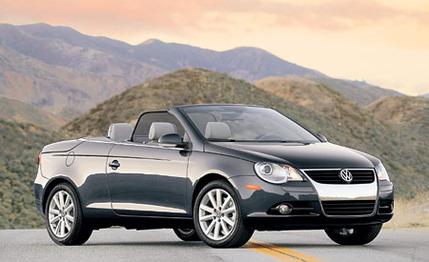
 First Drive Review
First Drive Review
With an estimated base price of 30 grand, Volkswagen's new hardtop convertible, the Eos, will be one of the most affordable vehicles of its type in the U.S. market when it arrives this September (Pontiac's upcoming G6 convertible being the only competitor in the price segment). The car promises exclusivity on a number of other fronts.
First of all, it is not a derivative of any existing sedan model, despite the liberal use of carry-over platform technology from the Golf and Passat. Second, fully automatic hardtop convertibles are rare on the ground here, and those that do appear in U.S. showrooms are typically of the luxury persuasion (read "expensive"), such as the Lexus SC430 and Volvo C70. And finally, both Eos models heading for our shores are well-equipped high-performance versions. Although Europe will be offered naturally aspirated four-cylinder and turbo-diesel variants in the lineup, we get only the turbocharged 200-hp, 2.0-liter four and 250-hp, 3.2-liter V-6 models.
Ironically, U.S. writers mainly drove the 114-hp unboosted 2.0-liter European model during an opportunity to piggyback onto a European Eos preview in Southern California. No biggie. We've driven Golfs and Jettas with the same 2.0T engine and transmission options (including VW's brilliant DSG) that will power our base Eos.
Of more interest is the Eos's structure. We know that VW drivetrains are stout and that the company understands a thing or two about vehicle dynamics, and we know that practicality and refinement are of equal importance in a convertible. Here, the Eos development team seems to have done a good job. The body structure is based on that of the new Golf, but with increased rocker-sill cross sections for improved stiffness. The windshield frame, which extends downward to the floor, is fabricated from hot-stamped ultra-high-strength steel, and behind the front-seat passengers, where the old Golf cabrio sported a basket-handle roll hoop for support, the Eos has an inverted version of the same thing. A steel tube runs down behind the doors and under the floor and soaks up some rear-seat room. The Eos has about 10 fewer inches of shoulder room than the current Golf. Although the structure is Golf-based, the sheetmetal adorning it is new, and the suspension on which it stands is derived from the Passat.
That gives the Eos a much wider stance-it has a broader track than the Golf-and provides it with bigger brakes. (Since the Passat range extends to a V-6-powered 4Motion wagon with a fairly hefty GVWR, it sports bigger binders.)
With its relatively short wheelbase and wide track, the Eos has eye-pleasing dimensions. Even the tail section eschews the bulbous shape afflicting most hardtop convertibles; its 11-cubic-foot trunk loses about half its volume when the top is lowered. The storage space doesn't completely disappear because of the artful way this Webasto-supplied roof stows itself. Instead of the main section folding in half (which stacks the panels the wrong way relative to their profiles), the center panels are packed one atop the other, like dishes, which greatly reduces the stack height in the trunk.
Another reason the Eos has a more attractive derrière than, say, a Peugeot 206CC (available only abroad) or even the butt-ugly Lexus SC430 is that its Slovenian designer, Robert Lesnik, worked hard to avoid a monolithic look. Accent grooves that run along the sides and continue above the rear wheel combine with subtle contours on the deck itself to reduce the impression of bulk, and prominent taillights, a contoured rear bumper, and flared wheel housings provide surface detail.
Still, the rear aspect is arguably not the car's strongest asset. It's better in profile, where the curvaceous roofline (when it's up) and short front overhang give the car a strong cab-forward emphasis. Although the front end is quite reminiscent of its Golf and Jetta stablemates, the hoodline is lower, with headlamps that are located farther toward the sides of the car. The grille and the lower fascia are substantially different.
Equipped with a pop-up mesh-in-frame windshield-header spoiler, the Eos is surprisingly quiet at speed. A rear wind blocker is supplied, too, but we found the car tolerable without it. To our great relief, we discovered that the Eos drives like a Golf, with crisp steering responses, well-damped ride motions, and stable handling. At the end of the day (dawn goddess notwithstanding), the Eos looks to be among the best convertible values in town.